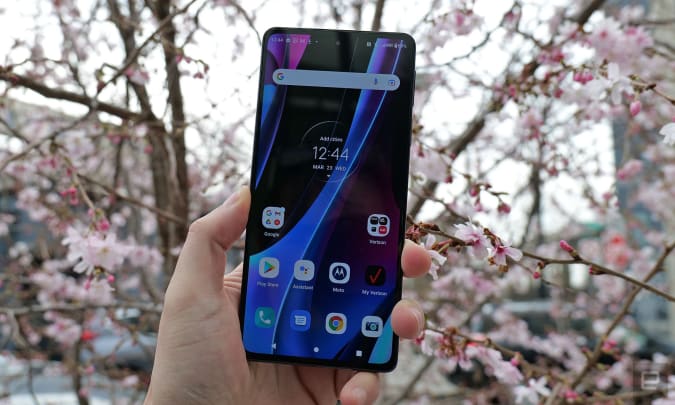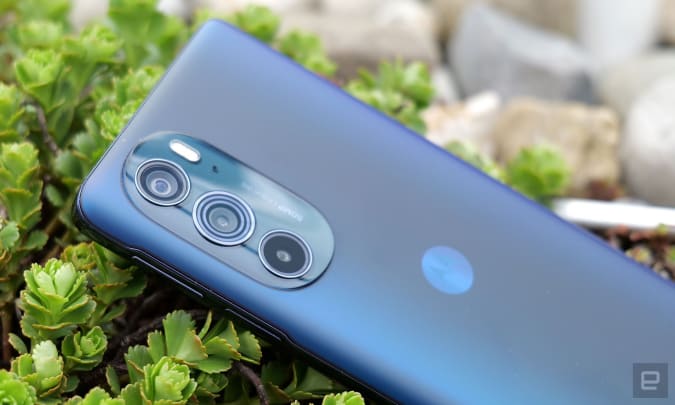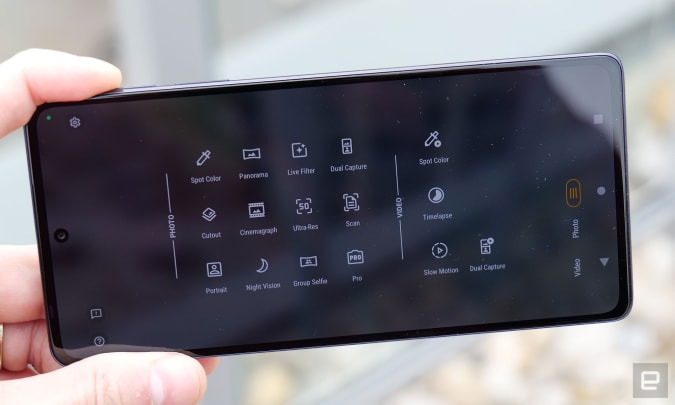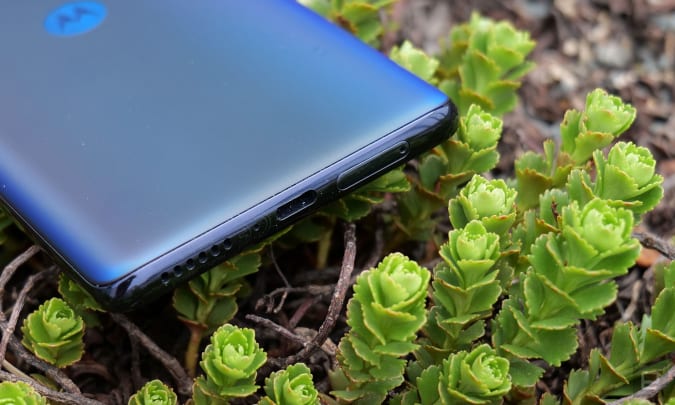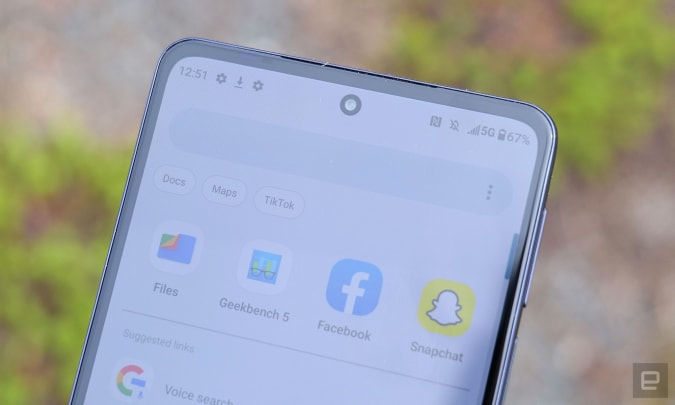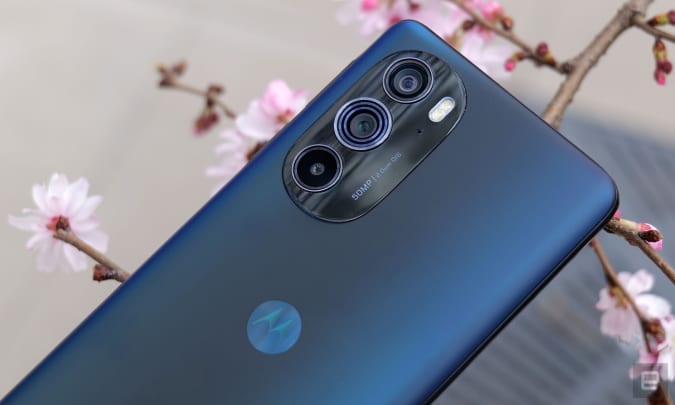In 2020, Motorola’s Edge+ marked a return to form for the company — a renewed focus on flagship phones after years of putting out more affordable devices. And despite skipping an update last year, now the 2022 Edge+ has arrived sporting a new chip and some inspiration Moto cribbed from Samsung’s playbook: built-in stylus support. Unfortunately, even with a slick 144Hz screen and a $1,000 list price that undercuts the Galaxy S22 Ultra, the Edge+ doesn’t live up to its premium ambitions. And at this point I’m wondering if Moto really has the chops to hang with other top-tier phone makers.
Design and display
Available in two colors (blue and white), the Edge+ doesn’t do much to stand out, but I wouldn’t call it ugly either. In some respects, it’s more confused than anything. Packing a 6.7-inch 2,400 x 1,080 OLED display, the Edge+ is a chunky device, and just barely smaller than Samsung’s 6.8-inch Galaxy S22 Ultra. Despite its premium price, the Edge+’s frame is made of plastic, and its lackluster IP52 dust and water resistance won’t repel much more than a splash. So you better keep this thing away from sinks and toilets.
pros
- Big 144Hz screen
- Good performance
- 30-watt power brick comes included
- Rich stereo speakers
cons
- overpriced
- Even 5G compatibility
- No telephoto camera
- Poor low-light image quality
- Stylus is an optional extra
- Limited water resistance
- Only two years of Android updates
- No headphone jack or microSD
Sam Rutherford/Engadget
Around back, while I like the gradient effect you get from the phone’s Gorilla Glass 5 rear panel, the see-through housing around the Edge+’s triple camera module looks out of place. Actually, I’m not sure why that glass is there at all, aside from possibly making it look a bit more like an iPhone 13. And because the Edge’s cameras aren’t totally flush, you get more of a camera mound than a full camera bump, which seems like a compromise that won’t please anyone.
I’m also sad that Moto axed the previous Edge+’s headphone jack. With so many other Android phones having done the same in recent years, retaining support for 3.5mm audio could have been an easy way for the Edge+ to differentiate itself from the competition. Now it’s just a missed opportunity.
Sam Rutherford/Engadget
Thankfully, when it comes to the display itself, there’s not much to complain about. It’s big, it’s colorful and, although its peak brightness of around 600 nits isn’t nearly as high as what you’d get from a S22+ (1,750 nits), content looks good anywhere without direct sunlight. Moto also included support for a 144Hz refresh rate, which is slightly faster than the 120Hz screens you get from Apple, Samsung and others. But while the screen does make things look very smooth, it’s hard to discern a difference in side-by-side comparisons with an S22+.
Finally, the Edge+ has a side-mounted fingerprint sensor built into its lock button, which is totally serviceable. That said, the phone’s buttons are close to the top of the device so reaching them can be a stretch, particularly for people with smaller hands. I really wish Moto had opted for an in-screen fingerprint reader (which the 2020 Edge+ also had) or a rear-mounted option, both of which I find more accessible.
cameras
Sam Rutherford/Engadget
While the Edge+’s rear cameras don’t look out of place, they might be the worst part of the phone’s entire kit. To start, one of the phone’s rear “cameras” is merely a 2-megapixel depth sensor, which leaves a 50MP main sensor along with a 50MP ultra-wide sensor that can also take macro shots. Right away, the lack of a dedicated telephoto cam is a serious demerit among premium phones. But it gets worse because the Edge+’s image quality can only be described as depressing.
In well-lit conditions, the phone does fine, taking bright pictures with punchy colors. However, I should mention that with default settings, photos tended to look one or two stops more exposed than I like. You also have to be careful about spotting when Moto’s scene optimizer automatically turns on, you risk some funky processing. For example, when I shot a very normal picture of some fruit, the Edge+ activated its food mode, which amped up colors to the point where the oranges looked neon.
Gallery: Moto Edge+ 2022 camera samples | 10 photos
Gallery: Moto Edge+ 2022 camera samples | 10 photos
But the biggest issue is the phone’s low-light photography. No matter what I did, unless there were multiple street lights right next to me, the Edge+ struggled to snap a sharp pic at night. Things like leaves and branches routinely came out blurry, with Moto’s Night Vision feature consistently capturing grainer photos when compared to the S22’s Night Mode. In even darker conditions, the Edge+ felt lost, producing an image of a stained glass window that looked more like an impressionist painting than an actual photo. And let’s not forget, I’m comparing Moto’s Night Vision setting to Samsung’s Night Mode, which isn’t even as good as Night Sight on the Pixel 6. On a mid-range phone, these results might be more forgivable. But for something listed at four figures, it’s just sad.
Performance and sound
While the Edge+’s cameras don’t impress, thankfully the phone’s performance and sound are strong. You get a Qualcomm Snapdragon Gen 1 chip, 8GB of RAM (or 12GB if you buy an upgraded model direct from Moto), and up to 512GB of storage. Overall, benchmarks were within five percent of what we’ve seen from Samsung’s Galaxy S22 line, and in the real world, I didn’t experience any hitches.
Sam Rutherford/Engadget
The Edge+ also features stereo speakers with Dolby Atmos that deliver relatively rich audio for a device this size. That said, I found that its speakers are better for watching movies than listening to music. For films that support surround sound, the Edge+ was slightly better at delivering layered, directional audio, especially for things like footsteps and explosions.
Accessories and 5G
One of the Edge+’s highlight features is active pen support and Motorola’s optional Smart Stylus. In theory, this should help transform the Edge+ into a slightly cheaper alternative to Samsung’s Galaxy S22 Ultra. Unfortunately, Motorola did not provide one for review alongside the phone, which doesn’t inspire a lot of confidence. On top of that, the phone doesn’t have built-in pen storage, so you’ll also need to use the folio cover that comes bundled with Moto’s stylus to create a more cohesive package that you might actually want to carry around.
As for 5G, support varies greatly depending on your carrier. On Verizon, you get both sub-6GHz and mmWave 5G. On T-Mobile/MetroPCS and unlocked models you only get sub-6GHz 5G, and on AT&T/Cricket, you’re stuck with 4G LTE. This discrepancy when it comes to 5G compatibility is borderline infuriating, and unless you’re on Verizon and have no intentions of switching, it almost makes the Edge+ a complete non-starter.
software
Sam Rutherford/Engadget
The Edge+ comes pre-installed with a straightforward take on Android 12, though our Verizon-branded review unit was loaded with a fair amount of bloatware. All your beloved Moto gestures are still around, including my longtime favorite, the double-chop to activate the flashlight. And as a bonus for people new to the Moto ecosystem, there’s a handy floating button that guides you through the various gestures, navigation options and more. There’s also Moto’s Ready For mode, which allows the phone to function like a mini desktop when hooked up to an external monitor. And while it works, it’s not nearly as good as Samsung’s Dex mode.
What’s really annoying, though, is that for a premium handset, Motorola’s long-term support is weak. You only get two years of Android updates and three years of bi-monthly security patches. In comparison, Samsung offers four years of both for all of its Galaxy S phones and many of its mid-range devices, while the Pixel 6 gets a whopping five years of OS upgrades and security updates.
Charging and battery life
Thanks to its 4,800 mAh battery, even with a large display sucking up juice, the Edge+ lasted a respectable 15 hours and 24 minutes on our local video rundown test. That’s about half an hour longer than the standard S22, though still a bit short compared to the S22+ and S22 Ultra’s times of 17:33 and 17:16, respectively. And during normal use, the Edge+ fared even better, often finishing the day with more than 30 percent battery left in the tank, due in part to efficient standby power usage that only robbed one or two percent battery an hour while idle.
Sam Rutherford/Engadget
Recharging the Edge+ can be done in two ways: wired charging at up to 30 watts (and yes, a power adapter does come in the box) or Qi wireless charging at up to 15 watts. On top of that, the phone supports reverse wireless charging (aka Power Share) at up to five watts, so you can send excess juice to a friend with a device in need or recharge Moto’s Smart Stylus.
wrap up
Back in 2020, I was cautiously optimistic to see Motorola get back into the flagship phone game with the original Edge+, even if that phone ended up being just fine. Motorola is the third biggest phone maker in the US, so you’d think it might have a decent shot at making a compelling alternative to Google, Apple and Samsung’s high-end devices. But now, having checked out its latest high-end phone, I feel like this whole endeavor might have been a mistake.
Aside from its screen and chipset, the 2022 Edge+ feels more like a mid-range handset than a truly premium phone. It’s lacking the telephoto cam that other flagships (and the previous model) have, and Moto’s low-light photo quality seems like it’s gotten worse, not better. Same goes for some of the Edge+’s other specs like its side-mounted fingerprint reader, which is a step back from the in-screen sensor on its predecessor. Moto even killed the headphone jack, which was one of the 2020 Edge’s defining features, and a real rarity among high-end phones.
Sam Rutherford/Engadget
Sure, this year’s Edge+ got a small boost thanks to a third year of security patches. But when you look at competing Android devices, Motorola’s software support still falls woefully short of what you get from Samsung and Google. With limited or no 5G connectivity on two of the US’s three biggest carriers, the Edge+ is a hard phone to like, let alone recommend. And while you might be tempted by some of the phone’s promo pricing at launch that could lop $100 to $150 off its price tag, even with those discounts, the Edge+ still feels too expensive. At $700, the Pixel 6 is a better (and cheaper) phone, and if you don’t mind only having sub-6GHz 5G, you can get an unlocked model directly from Google for just $600.
Honestly, the Edge+ feels like a trap: It has the build and cameras of a mid-range phone with a couple of high-end features to lure you in. But it’s missing a lot of the polish and sophistication you should be getting on a top -animal device. And while I can’t tell how much carrier partnerships or the ongoing chip crunch may have held this device back, regardless of how we got here, it really seems like Motorola is struggling to compete in the premium phone space.
All products recommended by Engadget are selected by our editorial team, independent of our parent company. Some of our stories include affiliate links. If you buy something through one of these links, we may earn an affiliate commission.

